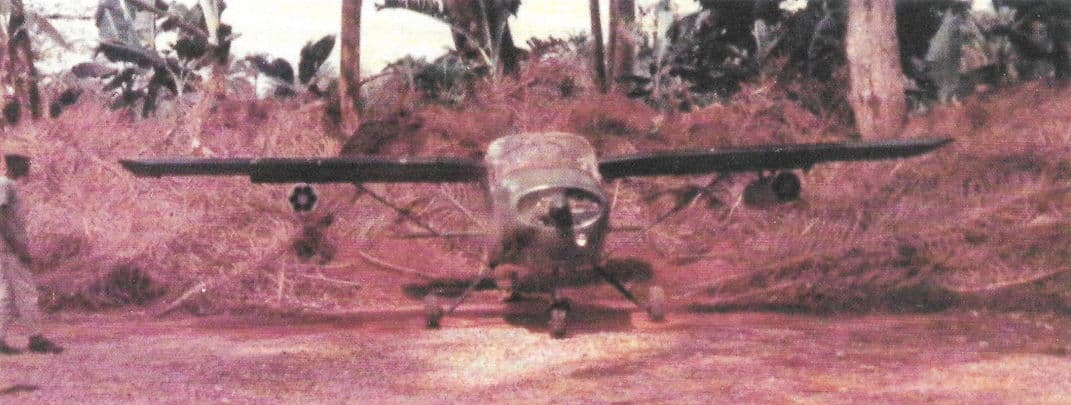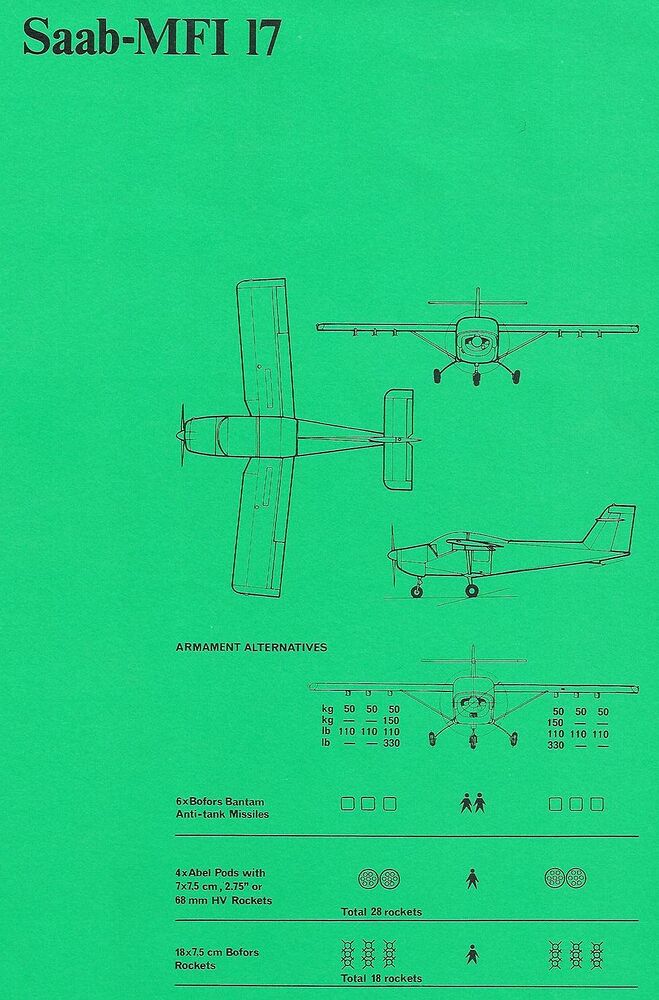
Introduction
The Saab MFI-17 Supporter is a light attack and trainer aircraft developed in Sweden, evolving from the civilian MFI-15 “Safari.” Designed to be cost-effective and versatile, it saw military adoption due to its ability to carry a variety of armaments and equipment, making it suitable for ground attack roles. But also as a Trainer, due to it being cost effective and easy to fly
History
The origins of the MFI-17 Supporter trace back to the early 1970s when Malmö Flygindustri developed the MFI-15 Safari, a general-purpose light aircraft with excellent visibility and handling characteristics. First flown in 1971, it was initially designed for civilian training and utility roles. Recognizing its potential for military applications, Saab adapted the MFI-15 into the MFI-17 Supporter, which took its maiden flight on July 6, 1972. This military-oriented version was equipped for roles such as training, artillery observation, forward air control, and liaison duties.
The MFI-17 was eventually adopted by several air forces, including Denmark and Zambia. The Royal Danish Air Force procured 32 aircraft, designated as T-17s, for pilot training. Pakistan also produced the aircraft under license as the MFI-17 Mushshak, which remains in service to this day. The aircraft’s agility and adaptability made it a valuable asset for smaller air forces.
This aircraft could fill a unique gap in War Thunder’s Swedish tech tree, offering a highly maneuverable light attacker in lower BRs, while its Bantam missile variant could function at a mid-tier BR for ground battles.
Specifications

General characteristics:
• Crew: 1 (or 2 with Bantam ATGM variant)
• Length: 7.02 m
• Wingspan: 8.85 m
• Height: 2.60 m
• Empty weight: 794 kg
• Loaded weight: ~1,200 kg (varies by payload)
• Powerplant: 1 × Lycoming IO-360-A1B6 piston engine, 200~ hp
Performance:
• Max speed: 236 km/h
• Cruising speed: ~200 km/h
• Service ceiling: 4,100 m
• Range: 622 km
Armament

Hardpoints: 6 underwing pylons with a variety of weapon configurations.
• Center and inner pylons: 4x Abel pods, each carrying 7x 7.5 cm Sprängraket m/55 “Frida” (total: 28 rockets)

• Single 135mm HE & HEAT: as in the AJ37 pods rocket, that can in theory be mounted on the inner two pylons, resulting in a total of four across the wings.

• Bofors Bantam ATGMs: 6x missiles (requires additional crew member for guidance)

• Machine Gun Pods: 2x FFV UNI-POD 0127, each with 1x 12.7 mm M3 HMG (200 rounds per pod)
Pros & Cons
Pros:
✔ A upgrade to the B17A having better armaments if placed at 3.3
✔ FFV UNI-POD 0127 12.7mm Gun pods cannot jam
✔ Highly maneuverable, excellent low-speed handling
✔ Versatile armament (rockets, gun pods, ATGMs)
✔ Bantam missiles offer guided attack capabilities
✔ Lightweight and easy to control
✔ Small and therefore harder to hit
Cons:
✖ Very slow, being easily out-sped by all aircraft at its proposed tiers
✖ No armor protection, easily destroyed by enemy fire
✖ Low ordnance capacity compared to heavier attackers
✖ No bombs
✖ Bantam variant (7.3 BR) faces jets, making it very vulnerable against everything
Comparison to Similar Swedish Aircraft
| Aircraft | Role | Primary Armament | Max Speed | Durability | Agility | BR Range |
|---|---|---|---|---|---|---|
| 🇸🇪 (In-theory)Saab MFI-17 (No Bantams) | Light CAS / Trainer | 7.5cm Frida, 12.7mm gun pods | 236 km/h | Very weak | Very high | 3.3 |
| 🇸🇪 (In-theory)Saab MFI-17 (With Bantams) | Light CAS / AT Support | Bantam ATGMs, rockets, gun pods | 236 km/h | Very weak | Very high | 7.3 |
| 🇸🇪 B 17A | Dive Bomber / CAS | bombs | 395 km/h | Medium | Average | 2.7 |
| 🇸🇪 B 18B | Attack Bomber | 13.2mm MGs, bombs, rockets | 590 km/h | Sturdy | Average | 4.0 |
| 🇸🇪 A 21A-3 | Attack Fighter | 20mm cannon, 13.2mm MGs, bombs, rockets | 660 km/h | Sturdy | Average | 4.3 |
The MFI-17 Supporter without Bantams would act as a low-tier, highly maneuverable CAS aircraft, similar to early dive bombers like the B 17A, but with better versatility and weaker survivability. The Bantam-equipped version would be a unique 7.3 attacker, offering guided missile capabilities before the Saab 105G. However, its low speed makes it easy prey for jet fighters.
All pictures
Implementation in War Thunder
The MFI-17 could be implemented in two ways:
- Tech tree variant (3.3 - 4.0 BR) – Equipped with machine gun pods and rockets, placed after the B 17A.
- Bantam ATGM variant (7.3 BR) – Added as a premium, event, or squadron aircraft due to its guided weapon capability.
- Yes
- No
- Only Without! (Most likely BR 3.3-4.0)
- Both (One at BR 3.3-4.0~ and one later at 7.3~)
- Only With! (Most likely BR 7.3 located before the SK-60B)
- I said no. [/poll]
- Rank II (after the B17A)
- Rank III
- Rank IV (Before The A21A-A3)
- I said no.
- Event
- Premium
- Tech Tree
- I said no.
Sources
Sammanfattning
https://smb.nu
https://www.aef.se
https://aeroseum.se/saab-mfi-15-till-aeroseum/
Saab MFI-15 Safari / MFI-17 Supporter - Specifications - Technical Data / Description
SAAB Trainers: Safir, SAAB 105, & Supporter
https://www.reddit.com/r/WeirdWings/comments/bzka1u/saab_mfi15_safari_mfi17_supporter_mfi17_mushshak/
https://www.pprune.org/private-flying/585447-saab-mfi-15-safari-mfi-17-supporter.html
https://www.globalsecurity.org/military/world/pakistan/mfi-17.htm
https://www.airforce-technology.com/projects/mfi-17-trainer/
Saab‐MFI 17—Army co‐operation and trainer aircraft | Emerald Insight
Saab Safari - Wikipedia
PAC MFI-17 Mushshak - Wikipedia
Saab Safari | Military Wiki | Fandom
MFI-17 Mushshak/ Super Mushshak


























